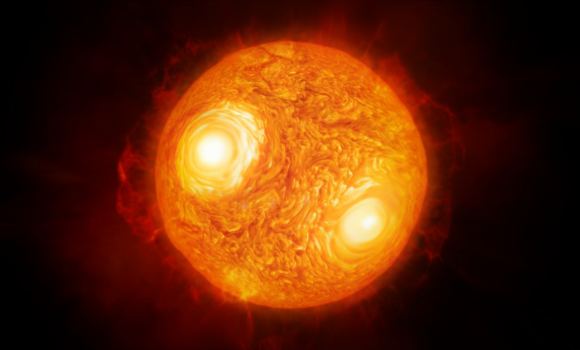When stars exhaust their supply of hydrogen fuel, they exit the main sequence phase of their evolution and enter into what is known as the Red Giant Branch (RGB) phase. This is characterized by the stars expanding significantly and becoming tens of thousands of times larger than our Sun. They also become dimmer and cooler, which lends them a reddish-orange appearance (hence the name).
Recently, a team of astronomers used the ESO's Very Large Telescope Interferometer (VLTI) to map one such star, the red supergiant Antares. In so doing, they were able to create the most detailed map of a star other than our Sun. The images they took also revealed some unexpected things about this supergiant star, all of which could help astronomers to better understand the dynamics and evolution of red giant stars.
The study which details their work, titled "Vigorous Atmospheric Motions in the Red Supergiant Supernova Progenitor Antares", recently appeared in the journal Nature. As indicated in the study, the team - which was led by Keiichi Ohnaka, an associate professor at the UCN Institute of Astronomy in Chile = relied on the VLTI at the ESO's Paranal Observatory in Chile to map Antares's surface and measure the motions of its surface material.

Artist's impression of the red supergiant star Antares, located 550 ly away in the constellation of Scorpius. Credit: ESO/M. Kornmesser
The purpose of their study was to chart how stars that have entered their RGB phase begin to change. The VLTI is uniquely suited to this task, since it is capable of combining light from four different telescopes - the 8.2-metre Unit Telescopes, or the smaller Auxiliary Telescopes - to create one virtual telescope that has the resolution of a telescope lens measuring 200 meters across.
This allows the VLTI to resolve fine details far beyond what can be seen with a single telescope. As Prof. Ohnaka explained in a recent ESO press statement:
"How stars like Antares lose mass so quickly in the final phase of their evolution has been a problem for over half a century. The VLTI is the only facility that can directly measure the gas motions in the extended atmosphere of Antares — a crucial step towards clarifying this problem. The next challenge is to identify what's driving the turbulent motions."
For their study, the team relied on three of the VLTI Auxiliary Telescopes and an instrument called the Astronomical Multi-BEam combineR (AMBER). This near-infrared spectro-interferometric instrument combines three telescopic beams coherently, allowing astronomers to measure the visibilities and closure phases of stars. Using these instruments, the team obtained images of Antares' surface over a small range of infrared wavelengths.
From these, the team was able to calculate the difference between the speed of atmospheric gas at different locations on Antares' surface, as well as its average speed over the entire surface. This resulted in a two-dimensional velocity map of Antares, which is the first such map created of another star other than the Sun. As noted, it is also the most-detailed map of any star beyond our Solar System to date.
The study also made some interesting discoveries of what takes place on Antares' surface and in its atmosphere. For example, they found evidence for high-speed upwellings of gas that reached distances of up to 1.7 Solar radii into space - much farther than previously thought. This, they claimed, could not be explained by convection alone, the process whereby cold material moves downwards and hot material upwards in a circular pattern.
This process occurs on Earth in the atmosphere and with ocean currents, but it is also responsible for moving pockets of hotter and colder gas around within stars. The fact that convection cannot explain the behavior of Antares extended atmosphere would therefore suggests that some new and unidentified process common to red giant stars must be responsible.
These results therefor offer new opportunities for research into stellar evolution, which is made possible thanks to next-generation instruments like the VTLI. As Ohnaka concluded:
"In the future, this observing technique can be applied to different types of stars to study their surfaces and atmospheres in unprecedented detail. This has been limited to just the Sun up to now. Our work brings stellar astrophysics to a new dimension and opens an entirely new window to observe stars."
Not only is this kind of research improving our understanding of stars beyond our Solar System, it lets us know what to expect when our Sun exits it main sequence phase and begins expanding to become a red giant. Though that day is billions of years away and we can't be certain humanity will even be around by that time, knowing the mechanics of stellar evolution is important to our understanding of the Universe.
It pays to know that even after we are gone, we can predict what will still be here and for how long. Be sure to check out this 3D animation of Antares, courtesy of the ESO:
Further Reading: ESO, Nature
No comments:
Post a Comment